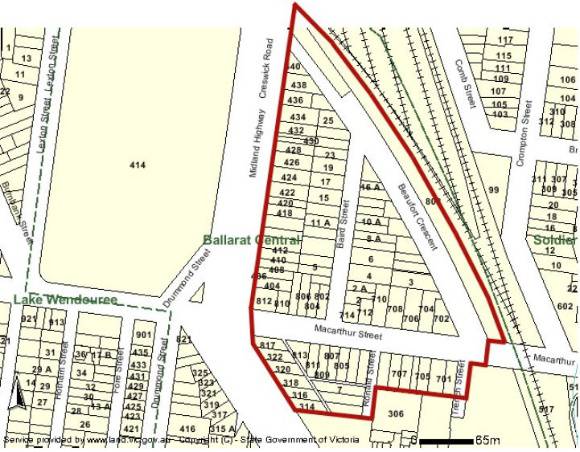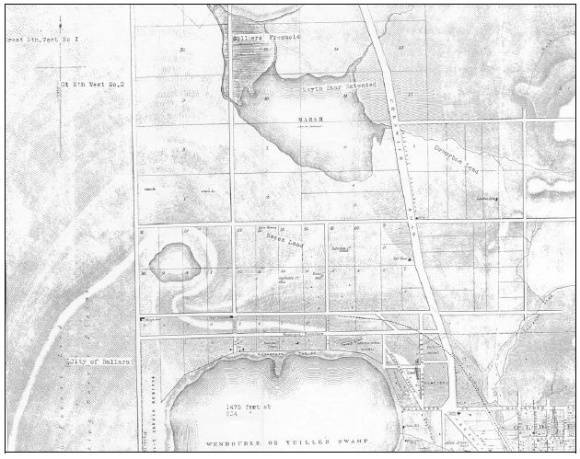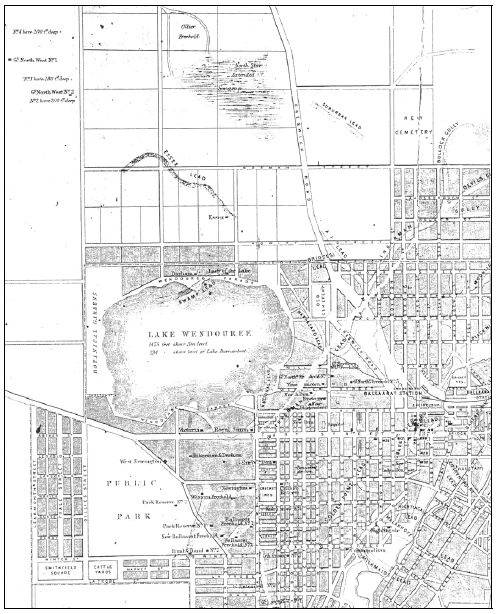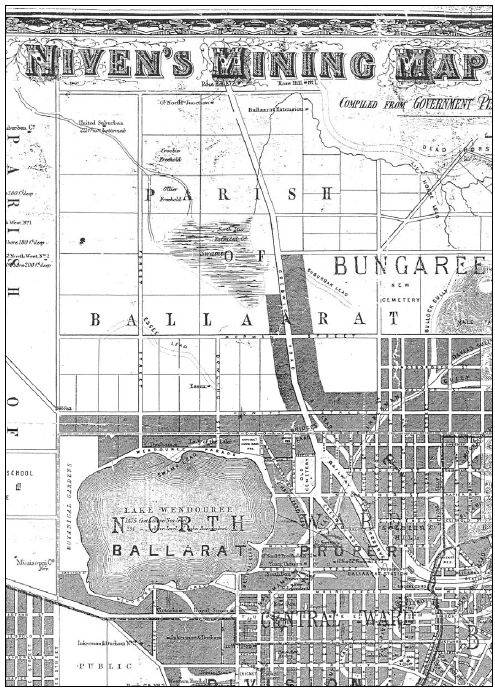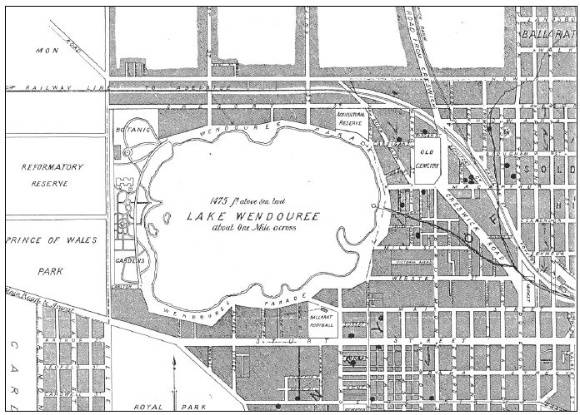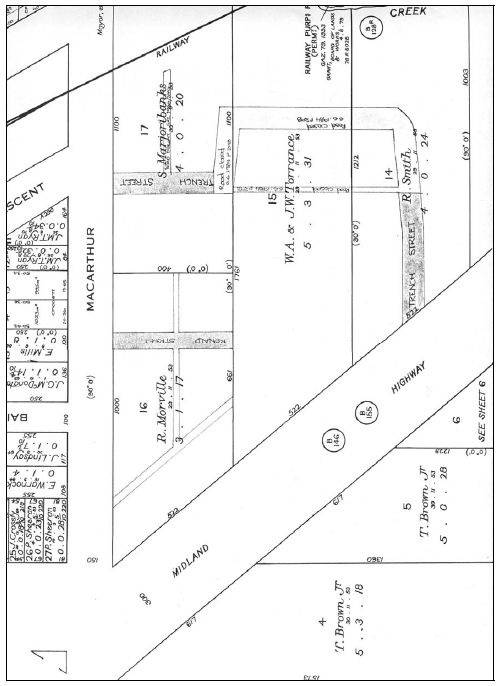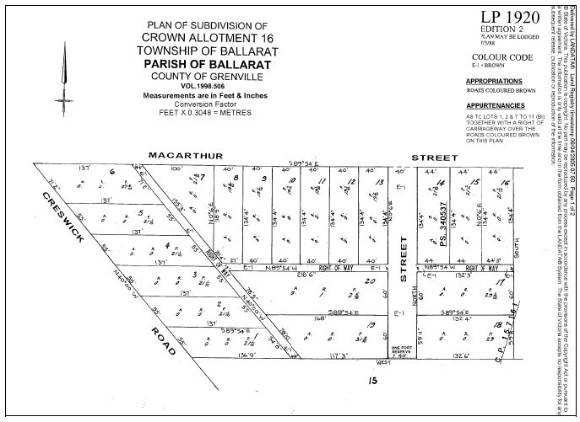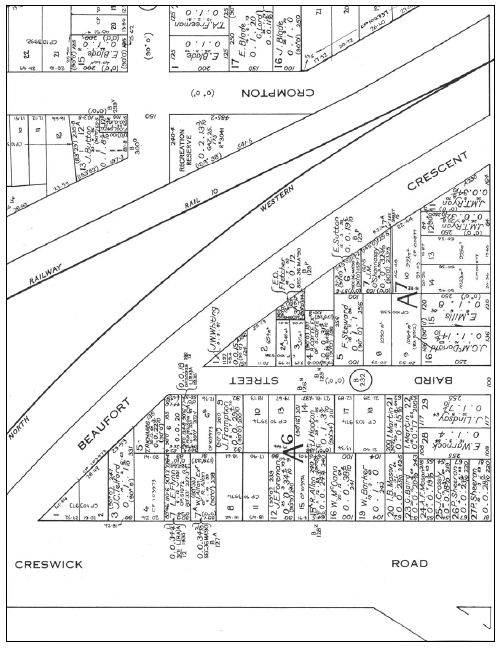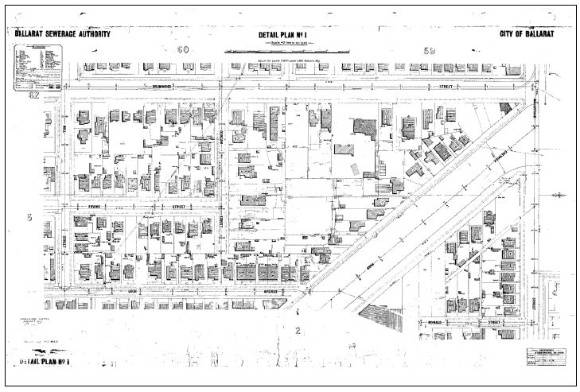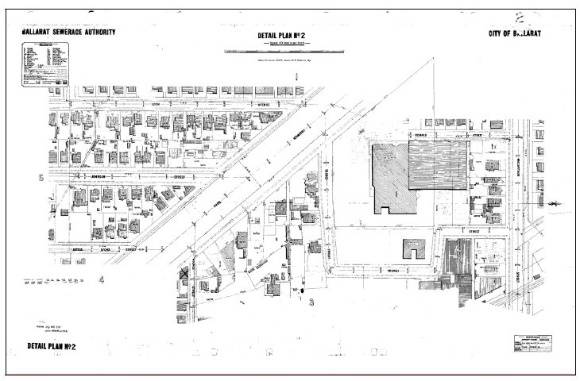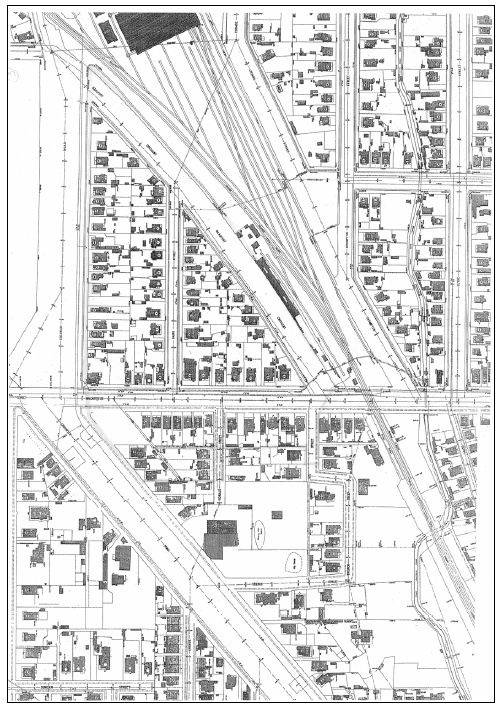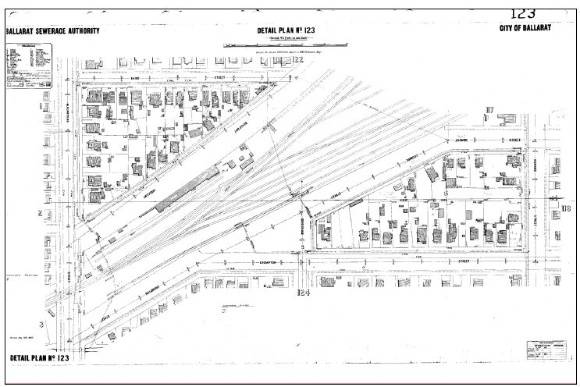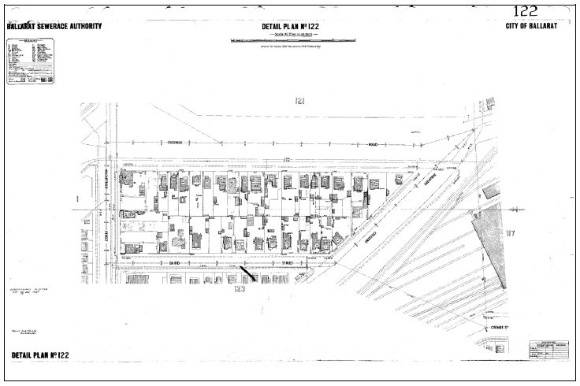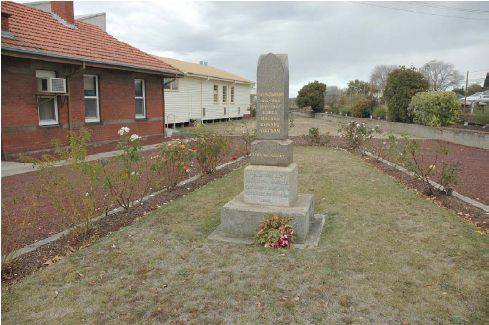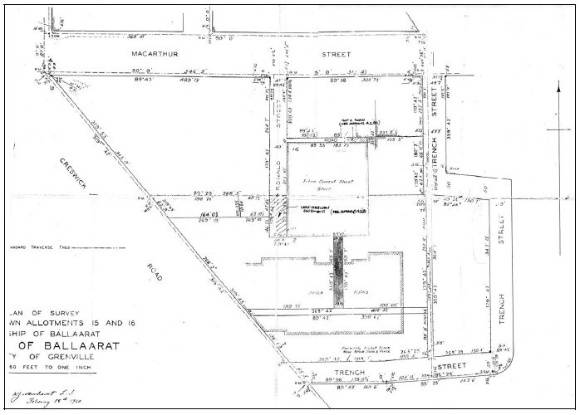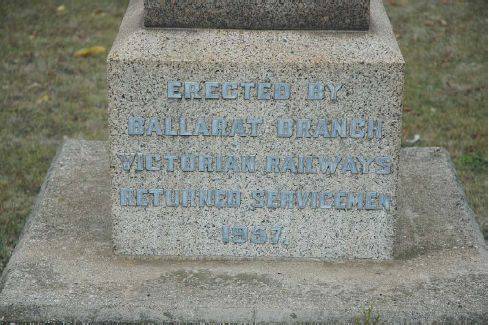| Back to search results » | Back to search page » |
|
Creswick Road and Macarthur Street Precinct
Statement of Significance
What is significant?
How is it significant?
Why is it significant?
The Creswick Road and Macarthur Street Heritage Precinct has significance for its notable concentration of predominantly and moderately intact dwellings built between the second half of the 19th century and the interwar (c.1920-1945) period. Overall, 69% of the dwellings have significance within the area. These dwellings demonstrate original and early design qualities of Victorian, Late Victorian, Edwardian and interwar Bungalow styles, reflecting important eras of residential development for the area. Primarily situated on Creswick Road and Macarthur Street, the precinct was largely an open area in 1861, with these roads having been laid out to service the rapidly expanded population as a result of the gold rush from 1851. The area was subdivided into residential allotments from c.1863 (the land north of Macarthur Street), with further allotments sold south of Macarthur Street from 1888, although the Crown Hotel opened in 1857 at the south-east corner of Creswick Road and Macarthur Street and there were houses dotted along these roads by 1861. None of these original buildings appear to survive today and the existing building stock reflects the important changes resulting from the subdivisions of c.1863 and 1888. By 1904, the area was occupied by residents of broad socio-economic backgrounds: from the gentleman of "independent means" and solicitors; to the middle classes of teachers, police constables, tailors and office clerks; to the working classes comprising carpenters, butchers, labourers and not surprisingly railway employees and potters, given the nearby railway workshops and pottery factory (physical evidence survives in the brick chimney stack that forms a local heritage landmark). The creation of the western railway line (reserved as early as 1868) witnessed the formation of the curved railway reserve and adjoining thoroughfare known as Beaufort Crescent in c.1863. An Avenue of Honor known as "Monash Avenue" denoted today by rows of Maple and Ash trees along Beaufort Crescent were planted in 1916-17 in memory of those serving in the First World War. These trees, together with the row of Elms in Creswick Road, Pin Oaks on the east side of Baird Street, mix of Plane, Elm and Ash trees in Macarthur Street and the grassed nature strips, open bluestone spoon drains, grassed and graveled verges and notable number of front fences that reflect the design and construction of the dwellings also contribute to the significance of the area.
The Creswick Road and Macarthur Street Heritage Precinct is architecturally significant at a LOCAL level (AHC criterion D.2). It demonstrates original and early design qualities associated with the residential development of the area from the late 19th century until c.1945. These qualities are expressed in the Victorian, Late Victorian, Edwardian and interwar Bungalow styled dwellings that are all single storey in appearance and have detached compositions.
Intact and appropriate domestic designs for the area include the hipped and gabled roof forms (with simple or complex roof outlines having a pitch between 25 and 40 degrees), front or return verandahs, corrugated galvanised steel roof cladding, horizontal timber weatherboard wall construction, brick chimneys (detailed to reflect the design era), modest or wide eaves, timber verandah posts with decorative cast iron or timber brackets and/or valances, timber framed windows arranged singularly, in pairs or bays, and the rear location of carports and garaging. Overall, these dwellings constitute 69% of the building stock in the area. The surviving commercial buildings: the former Canberra Hotel at 812 Macarthur Street and the shop at 710 Macarthur Street also contribute to the architectural significance of the area.
The Creswick Road and Macarthur Street Heritage Precinct is aesthetically significant at a LOCAL level (AHC criteria D.2, E.1). It demonstrates important visual qualities that reflect the historical and residential development of the area. These qualities include the layout of the roads, streets and allotment configuration, views to the railway line (in Macarthur Street and Beaufort Crescent) and cemetery (Macarthur Street and Creswick Road) and views to the former Canberra Hotel, a local heritage landmark representing an early commercial enterprise in the area. Another local landmark, although outside the precinct, is the brick chimney stack represent a physical legacy of the 19th century pottery factory which was demolished in the 1960s. Particular landscapes of significance include the Avenue of Honor of Maple and Ash trees in Beaufort Crescent (known as "Monash Avenue"), row of Elms in Creswick Road, Pin Oaks on the east side of Baird Street, mix of Plane, Elm and Ash trees in Macarthur Street grassed nature strips, and the small front private gardens to several of the properties. The streetscapes within the precinct are also identified by front fencing that further enhances the significance of the area. These fences include the timber picket fences (up to 1200 mm high),
The Creswick Road and Macarthur Street Heritage Precinct is architecturally significant at a LOCAL level (AHC criterion D.2). It demonstrates original and early design qualities associated with the residential development of the area from the late 19th century until c.1945. These qualities are expressed in the Victorian, Late Victorian, Edwardian and interwar Bungalow styled dwellings that are all single storey in appearance and have detached compositions.
Intact and appropriate domestic designs for the area include the hipped and gabled roof forms (with simple or complex roof outlines having a pitch between 25 and 40 degrees), front or return verandahs, corrugated galvanised steel roof cladding, horizontal timber weatherboard wall construction, brick chimneys (detailed to reflect the design era), modest or wide eaves, timber verandah posts with decorative cast iron or timber brackets and/or valances, timber framed windows arranged singularly, in pairs or bays, and the rear location of carports and garaging. Overall, these dwellings constitute 69% of the building stock in the area. The surviving commercial buildings: the former Canberra Hotel at 812 Macarthur Street and the shop at 710 Macarthur Street also contribute to the architectural significance of the area.
The Creswick Road and Macarthur Street Heritage Precinct is aesthetically significant at a LOCAL level (AHC criteria D.2, E.1). It demonstrates important visual qualities that reflect the historical and residential development of the area. These qualities include the layout of the roads, streets and allotment configuration, views to the railway line (in Macarthur Street and Beaufort Crescent) and cemetery (Macarthur Street and Creswick Road) and views to the former Canberra Hotel, a local heritage landmark representing an early commercial enterprise in the area. Another local landmark, although outside the precinct, is the brick chimney stack represent a physical legacy of the 19th century pottery factory which was demolished in the 1960s. Particular landscapes of significance include the Avenue of Honor of Maple and Ash trees in Beaufort Crescent (known as "Monash Avenue"), row of Elms in Creswick Road, Pin Oaks on the east side of Baird Street, mix of Plane, Elm and Ash trees in Macarthur Street grassed nature strips, and the small front private gardens to several of the properties. The streetscapes within the precinct are also identified by front fencing that further enhances the significance of the area. These fences include the timber picket fences (up to 1200 mm high),
timber post and woven wire or cyclone fences (up to 1200 mm high), low interwar era brick fences with pier and trussed steel bays (up to 700 mm high) and the low interwar era solid brick fences, all of which relate to the design era of the dwellings within the properties. The early open bluestone spoon drains in Baird Street, Beaufort Crescent and Creswick Road (and the accompanying concrete cross overs and culverts), concrete upstands to the bluestone drains at one end of Beaufort Crescent, grassed and graveled road verges, and asphalt footpaths in Macarthur Street and Beaufort Crescent also contribute to the significance of the place. The lack of a visual presence of garages and carports from the street frontages further retains the aesthetic heritage values of the area.
The Creswick Road and Macarthur Street Heritage Precinct is historically significant at a LOCAL level (AHC criteria A.4, H.1). It is associated with important eras of residential development after the subdivision of the area in c.1863 and 1888, in the late 19th and early 20th centuries and during the interwar (c.1920-1945) period. Although there was housing in the area before 1861, together with the Crown Hotel that had opened in 1857 on the south-east corner of Creswick Road and Macarthur Street, subsequent major land subdivisions were the catalyst of the construction of the dwellings in the area today. The first major subdivision occurred north of Macarthur Street and included the creation of Baird Street (originally known as Wood Street) and the angled Beaufort Crescent as a result of the reservation of adjacent railway land and later opening the Ballarat to "Beaufort" railway line. Allotments in the first subdivision were sold from 1863 and involved 29 allotments between Creswick Road and Baird Street, with the remaining 16 allotments between Baird Street and Beaufort Crescent first sold from 1869. Land south of Macarthur Street was divided into 20 allotments in 1888. Although primarily a residential area, the precinct has associations with the former Canberra Hotel, built in 1866 as the Rose of Denmark and forms a local historical landmark. A number of the interwar dwellings in the area have associations with local builders, including A.L. Quayle (builder for 8, 8A and 11A Baird Street) and S.J. Weir (builder for 2 and 2A Baird Street and 714 Macarthur Street). There area also has associations with residents of a broad mix of socio-economic backgrounds in the 19th and early 20th centuries: from the gentleman of "independent means" and solicitors; to the middle classes of teachers, police constables, tailors and office clerks; to the working classes comprising carpenters, butchers, labourers and not surprisingly railway employees and potters, given the nearby railway workshops and pottery factory. There are also associations with the planting of the Avenue of Honor of Maple and Ash trees (known as Monash Avenue) in 1916-17 by the North Progress Association in honor of the soldiers of the area who were then serving in the First World War.
The Creswick Road and Macarthur Street Heritage Precinct is socially significant at a LOCAL level (AHC criterion G.1). In particular, the Avenue of Honor of Maple and Ash trees known as "Monash Avenue" is recognized by the local community for cultural and commemorative reasons with those soldiers who fought and died in the First World War.
Overall, the Creswick Road and Macarthur Street Precinct is of LOCAL significance.
The Creswick Road and Macarthur Street Heritage Precinct is historically significant at a LOCAL level (AHC criteria A.4, H.1). It is associated with important eras of residential development after the subdivision of the area in c.1863 and 1888, in the late 19th and early 20th centuries and during the interwar (c.1920-1945) period. Although there was housing in the area before 1861, together with the Crown Hotel that had opened in 1857 on the south-east corner of Creswick Road and Macarthur Street, subsequent major land subdivisions were the catalyst of the construction of the dwellings in the area today. The first major subdivision occurred north of Macarthur Street and included the creation of Baird Street (originally known as Wood Street) and the angled Beaufort Crescent as a result of the reservation of adjacent railway land and later opening the Ballarat to "Beaufort" railway line. Allotments in the first subdivision were sold from 1863 and involved 29 allotments between Creswick Road and Baird Street, with the remaining 16 allotments between Baird Street and Beaufort Crescent first sold from 1869. Land south of Macarthur Street was divided into 20 allotments in 1888. Although primarily a residential area, the precinct has associations with the former Canberra Hotel, built in 1866 as the Rose of Denmark and forms a local historical landmark. A number of the interwar dwellings in the area have associations with local builders, including A.L. Quayle (builder for 8, 8A and 11A Baird Street) and S.J. Weir (builder for 2 and 2A Baird Street and 714 Macarthur Street). There area also has associations with residents of a broad mix of socio-economic backgrounds in the 19th and early 20th centuries: from the gentleman of "independent means" and solicitors; to the middle classes of teachers, police constables, tailors and office clerks; to the working classes comprising carpenters, butchers, labourers and not surprisingly railway employees and potters, given the nearby railway workshops and pottery factory. There are also associations with the planting of the Avenue of Honor of Maple and Ash trees (known as Monash Avenue) in 1916-17 by the North Progress Association in honor of the soldiers of the area who were then serving in the First World War.
The Creswick Road and Macarthur Street Heritage Precinct is socially significant at a LOCAL level (AHC criterion G.1). In particular, the Avenue of Honor of Maple and Ash trees known as "Monash Avenue" is recognized by the local community for cultural and commemorative reasons with those soldiers who fought and died in the First World War.
Overall, the Creswick Road and Macarthur Street Precinct is of LOCAL significance.
Rationale to Statement of Cultural Significance
In accordance with the Victoria Planning Provision (VPP): Applying the Heritage Overlay, the Creswick Road and Macarthur Street Heritage Precinct has been assessed against the relevant Criteria for the Register of the National Estate.
This assessment has determined that the precinct has sufficient cultural significance to warrant its retention by its inclusion as a heritage overlay in the Ballarat Planning Scheme.
The Creswick Road and Macarthur Street Heritage Precinct is considered to meet the following relevant Criteria: A.4: Importance for its association with events, developments or cultural phases which have had a significant role in the human occupation and evolution of the nation, State, region or community.
The Creswick Road and Macarthur Street Heritage Precinct has been identified in the Historical Evidence and in the Statement of Significance as being associated with the subdivision of residential land from 1863, 1869 and 1888.
In the first instance, these subdivisions resulted from the need for further house building because of the rapidly expanded population as a result of the gold rush from 1851. The subsequent building development in the late 19th and early 20th centuries and during the interwar period reflects the evolution of housing needs in this area over an 80-year period, with the expansion of other industries and cultural and social developments, including the extension of the Ballarat to Beaufort railway line (now known as the Ballarat to Ararat railway line) adjacent the precinct that opened in 1874. The planting of the Avenue of Honor along Beaufort Avenue in 1916-17 and known as "Monash Avenue" continues as a physical and cultural legacy of the substantial impact of the First World War on the local area.
D.2: Importance in demonstrating the principal characteristics of the range of human activities in the Australian environment (including way of life, custom, process, land-use, function, design or technique).
Most of the existing allotment pattern within the Creswick Road and Macarthur Street Heritage Precinct reflects the important subdivisional land sales of 1863, 1869 and 1888. The existing significant housing stock demonstrates the design techniques of the important phases of building development in the area in the Victorian, Edwardian and interwar periods. While most of the dwellings are modestly scaled, they are generally moderately-highly intact examples of their particular types (Victorian, Edwardian and interwar Bungalow stylistic types) that collectively provide a significant aesthetic understanding of the three main building phases in the area.
E.1: Importance for a community for aesthetic characteristics held in high esteem or otherwise valued by the community.
The landscape features within the precinct - notably the Avenue of Honor in Beaufort Crescent, row of Elms in Creswick Road, Pin Oaks on the east side of Baird Street, mix of Plane, Elm and Ash trees in Macarthur Street grassed nature strips, and the small front private gardens - make a critical contribution to the aesthetic heritage character of the area. The street trees within the public domain are valued by the local community. In association with the landscaping is the early engineering infrastructure such as the bluestone spoon drains and graveled and grassed road verges that further contribute to the heritage character and appearance of the area.
G.1: Importance as a place highly valued by a community for reasons of religious, spiritual, symbolic, cultural, educational or social associations.
The Avenue of Honor of Maple and Ash trees known as "Monash Avenue" in Beaufort Crescent commemorates those local soldiers who fought and died in the First World War. This memorial avenue continues to be valued by the local community for cultural and commemorative reasons, although the cultural associations with the fallen soldiers is now not well-known throughout Ballarat.
In accordance with the Victoria Planning Provision (VPP): Applying the Heritage Overlay, the Creswick Road and Macarthur Street Heritage Precinct has been assessed against the relevant Criteria for the Register of the National Estate.
This assessment has determined that the precinct has sufficient cultural significance to warrant its retention by its inclusion as a heritage overlay in the Ballarat Planning Scheme.
The Creswick Road and Macarthur Street Heritage Precinct is considered to meet the following relevant Criteria: A.4: Importance for its association with events, developments or cultural phases which have had a significant role in the human occupation and evolution of the nation, State, region or community.
The Creswick Road and Macarthur Street Heritage Precinct has been identified in the Historical Evidence and in the Statement of Significance as being associated with the subdivision of residential land from 1863, 1869 and 1888.
In the first instance, these subdivisions resulted from the need for further house building because of the rapidly expanded population as a result of the gold rush from 1851. The subsequent building development in the late 19th and early 20th centuries and during the interwar period reflects the evolution of housing needs in this area over an 80-year period, with the expansion of other industries and cultural and social developments, including the extension of the Ballarat to Beaufort railway line (now known as the Ballarat to Ararat railway line) adjacent the precinct that opened in 1874. The planting of the Avenue of Honor along Beaufort Avenue in 1916-17 and known as "Monash Avenue" continues as a physical and cultural legacy of the substantial impact of the First World War on the local area.
D.2: Importance in demonstrating the principal characteristics of the range of human activities in the Australian environment (including way of life, custom, process, land-use, function, design or technique).
Most of the existing allotment pattern within the Creswick Road and Macarthur Street Heritage Precinct reflects the important subdivisional land sales of 1863, 1869 and 1888. The existing significant housing stock demonstrates the design techniques of the important phases of building development in the area in the Victorian, Edwardian and interwar periods. While most of the dwellings are modestly scaled, they are generally moderately-highly intact examples of their particular types (Victorian, Edwardian and interwar Bungalow stylistic types) that collectively provide a significant aesthetic understanding of the three main building phases in the area.
E.1: Importance for a community for aesthetic characteristics held in high esteem or otherwise valued by the community.
The landscape features within the precinct - notably the Avenue of Honor in Beaufort Crescent, row of Elms in Creswick Road, Pin Oaks on the east side of Baird Street, mix of Plane, Elm and Ash trees in Macarthur Street grassed nature strips, and the small front private gardens - make a critical contribution to the aesthetic heritage character of the area. The street trees within the public domain are valued by the local community. In association with the landscaping is the early engineering infrastructure such as the bluestone spoon drains and graveled and grassed road verges that further contribute to the heritage character and appearance of the area.
G.1: Importance as a place highly valued by a community for reasons of religious, spiritual, symbolic, cultural, educational or social associations.
The Avenue of Honor of Maple and Ash trees known as "Monash Avenue" in Beaufort Crescent commemorates those local soldiers who fought and died in the First World War. This memorial avenue continues to be valued by the local community for cultural and commemorative reasons, although the cultural associations with the fallen soldiers is now not well-known throughout Ballarat.
Significance of Dwellings
Sixty of the eight-seven dwellings (69%) within the Creswick Road and Macarthur Street Heritage precinct are considered to have significance within the area. The precinct also has eight buildings that may have individual significance.33 Further details and a photograph of each of the dwellings are provided in the Catalogue of Places as Appendix 2.4 (Volume 4).
The dwellings that are significant within the heritage precinct are:
2, 4, 5, 6, 8, 9, 11, 11A, 12, 13, 16A, 17, 18, 19, 23, 25, 27 Baird Street
3, 5, 25 Beaufort Crescent
314, 316, 318, 320, 322, 404, 406, 408, 410, 420, 424, 426, 428, 430, 432, 434, 436, 438 Creswick Road.
701, 702, 704, 705, 705A, 706, 707, 708, 710, 712, 801, 803, 805, 807, 808, 809, 811, 813 Macarthur Street
3, 5, 7 Ronald Street.
The dwellings that may have individual significance are:
9 Baird Street.
406, 434 Creswick Road.
702, 710, 803, 811, 812 Macarthur Street.
The properties that are not considered to have significance within the precinct are at:
2A, 7, 8A, 10, 10A, 14, 15, 16 Baird Street.
7, 9, 11, 13, 27 Beaufort Crescent.
412, 414, 416, 418, 422 Creswick Road.
699, 703, 709, 714, 802, 804, 806, 810, 817 Macarthur Street.
The dwellings that are significant within the heritage precinct are:
2, 4, 5, 6, 8, 9, 11, 11A, 12, 13, 16A, 17, 18, 19, 23, 25, 27 Baird Street
3, 5, 25 Beaufort Crescent
314, 316, 318, 320, 322, 404, 406, 408, 410, 420, 424, 426, 428, 430, 432, 434, 436, 438 Creswick Road.
701, 702, 704, 705, 705A, 706, 707, 708, 710, 712, 801, 803, 805, 807, 808, 809, 811, 813 Macarthur Street
3, 5, 7 Ronald Street.
The dwellings that may have individual significance are:
9 Baird Street.
406, 434 Creswick Road.
702, 710, 803, 811, 812 Macarthur Street.
The properties that are not considered to have significance within the precinct are at:
2A, 7, 8A, 10, 10A, 14, 15, 16 Baird Street.
7, 9, 11, 13, 27 Beaufort Crescent.
412, 414, 416, 418, 422 Creswick Road.
699, 703, 709, 714, 802, 804, 806, 810, 817 Macarthur Street.
Group
Residential buildings (private)
Category
Residential Precinct


